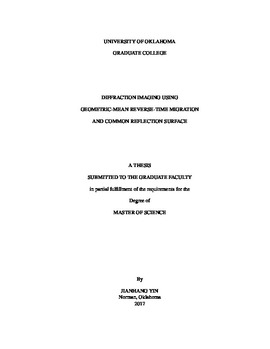| dc.contributor.advisor | Nakata, Nori | |
| dc.contributor.author | Yin, Jianhang | |
| dc.date.accessioned | 2017-12-18T14:45:13Z | |
| dc.date.available | 2017-12-18T14:45:13Z | |
| dc.date.issued | 2017-12 | |
| dc.identifier.uri | https://hdl.handle.net/11244/53077 | |
| dc.description.abstract | Diffracted waves contain a great deal of valuable information about small-scale subsurface structure such as faults, pinch-outs, karsts and fractures, which are tightly related to hydrocarbon accumulation and production. Therefore, diffraction separation and imaging with high spatial resolution play an increasingly critical role in seismic exploration. In this work, we first introduce a method named geometric-mean reverse time migration (GmRTM) to image only subsurface diffractors based on the difference of the wave phenomena between diffracted and reflected waves. Numerical tests prove the advantage of this method on diffraction imaging with high resolution as well as less artifacts event if we have small number of receivers and random noise added in data. Then we propose a workflow to extract diffraction information using a full data-driven method, called common reflection surface (CRS), before we apply GmRTM. Application of this workflow shows that GmRTM further improves the quality of the image by combining with diffraction separation technique CRS in the data domain. | en_US |
| dc.language | en_US | en_US |
| dc.subject | Geophysics. | en_US |
| dc.title | Diffraction imaging using Geometric-mean Reverse-Time Migration and Common Reflection Surface | en_US |
| dc.contributor.committeeMember | Chen, Xiaowei | |
| dc.contributor.committeeMember | Behm, Michael | |
| dc.date.manuscript | 2017-12 | |
| dc.thesis.degree | Master of Science | en_US |
| ou.group | Mewbourne College of Earth and Energy::Conoco Phillips School of Geology and Geophysics | en_US |
